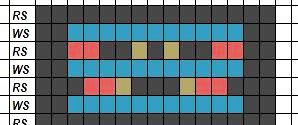Most of the patterns available on Ravelry are 9 stitches wide, plus a few stitches perhaps for borders. I've tried my hand at five different ones so far, many of which are very nearly the same thing with slight variations. I'll go over why these variations may be compelling, but let's get the winner out of the way:
 All of the bookmark patterns I worked over are generally articulated around either a two-point chevron (worked over 6 rows) or a three-point chevron (worked over 8 rows). I prefer the three point chevron, for the same reason that I prefer the patterns that called for no border at all: because the devil is in the blocking, not in the kind of side structuring done whilst knitting that we often feel drawn to (I understand all too well -- it is much faster, but it will give you heavier fabric, and this is lacy!). For this to lie flat and rectangular, you must block. I know, I hate blocking too. My cats love it, because they've assumed I've somehow dissected a toy mouse and laid it open for their amusement -- but trying to keep them away form the blocked goodie is a headache in itself.
All of the bookmark patterns I worked over are generally articulated around either a two-point chevron (worked over 6 rows) or a three-point chevron (worked over 8 rows). I prefer the three point chevron, for the same reason that I prefer the patterns that called for no border at all: because the devil is in the blocking, not in the kind of side structuring done whilst knitting that we often feel drawn to (I understand all too well -- it is much faster, but it will give you heavier fabric, and this is lacy!). For this to lie flat and rectangular, you must block. I know, I hate blocking too. My cats love it, because they've assumed I've somehow dissected a toy mouse and laid it open for their amusement -- but trying to keep them away form the blocked goodie is a headache in itself.Another quick note on blocking, before we get into the knitty-gritty of the pattern changes: some patterns call for starching of the bookmark. I find that this depends entirely upon the fiber used. The Koigu merino I settled on only needed blocking with water - which means less sticky cats! Hurrah!
Now back to our yarnovers. The pattern for a chevron done over 13 stitches goes like so:
Two-Point Chevron
continued for a Three-Point Chevron
For visually oriented folks like myself, we can figure both chevrons like so:

...where the colors indicate the stitches indicated by the legend below:
This is our basis. We'll build it up, flip it and reverse it along a median like the full version on the left below. So one two-point chevron, followed by two three-point chevrons, then our center:
knit across RS for two rows, purling across the WS of these
next RS: one row of two central holes [K2, KTOG, K2, YO, K1, YO, K2, S1,K1, PSSO, K2]
then knit two more RS rows across, as before the last RS row, before...
...finally resuming the pattern in reverse. This is essentially just swapping rows 3 and 7 above, but I've copied it below:

Two-Point Chevron
- row 1 (RS): knit
- row 2 (WS): k2, p9, k2
- row 3 (RS): k2, k2tog, YO, k5, YO, skp k2
- row 4 (WS): k2, p9, k2
- row 5 (WS): k3, k2tog, YO, k3, YO, skp, k3
- row 6 (WS): k2, p9, k2
continued for a Three-Point Chevron
- row 7 (RS): k2, k2tog, k2, YO, k1, YO, k2, skp, k2
- row 8 (WS): k2, p9, k2
A few notes on yarn choice:
I tried a very fuzzy alpaca (Garn Studio Drops) that was undoubtedly the worst. I checked with a lace-weight angora as well, and clearly fuzzy yarns are no bueño for this project. Went again with a barely fuzzy Malbrigo silk yarn in a nice warm fuschia, and it came out nice, although the weight is probably a bit too much. A wool blend of similar weight was simply to heavy and too fuzzy to allow the lacework to show nicely. When I brought out the fingering-weight Koigu Merino shown to the left in black, choirs sang and angels chanted and all that whatnot. Why did I bother proving what was obviously true from the get-go? Hmmm? To reinvent the wheel, of course.



